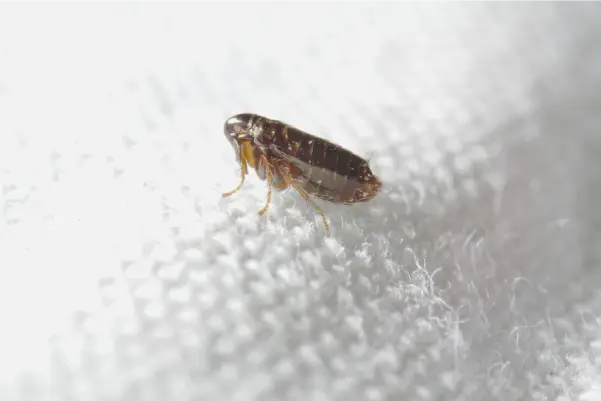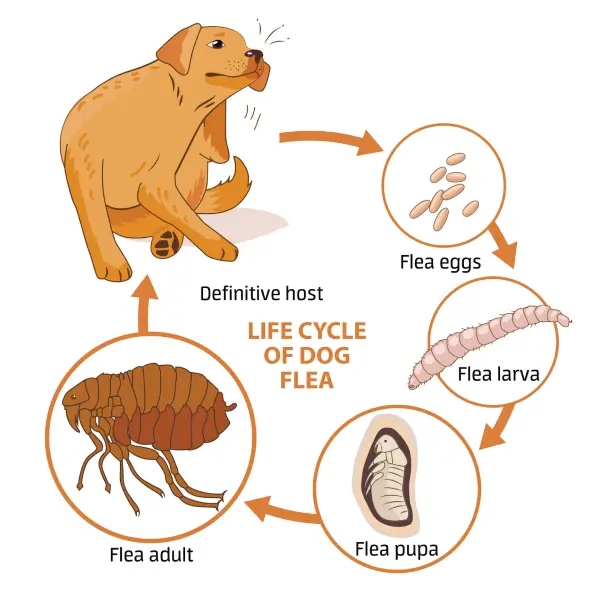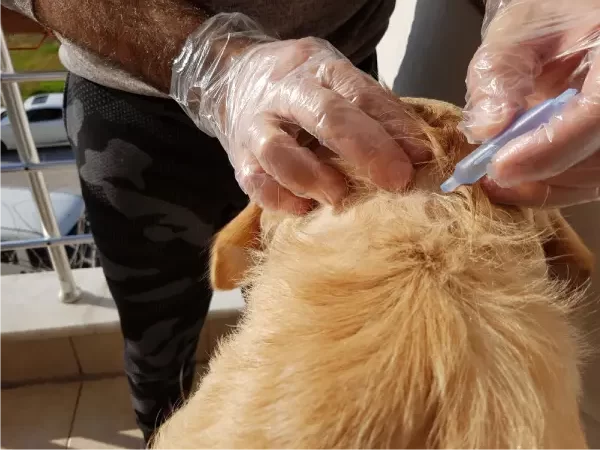Fleas: Tiny Jumpers, Big Problems!
Fleas may be small, but they bring discomfort for pets and big headaches for their humans. These tiny, biting pests reproduce rapidly, turning a few fleas into a full-blown infestation before you even realize it. Fleas thrive in carpets, pet bedding, and even cracks in flooring, making them difficult to eliminate without professional help. Whether your pet is constantly scratching or you have spotted small, fast-moving insects on furniture or floors, flea infestations should be addressed quickly to prevent itchy bites and ongoing discomfort.
If you are dealing with a flea problem, do not wait for it to get worse—contact us today for professional flea control solutions and restore comfort to your home and pets!
 Flea Control & Prevention
Flea Control & Prevention
Fleas are one of the most persistent and frustrating pests to eliminate. These tiny parasites reproduce at an astonishing rate, laying up to 50 eggs per day, making it critical to address infestations quickly. Fleas do not just affect pets—they can bite humans, spread throughout the home, and be incredibly difficult to remove once established. Professional flea control is highly recommended to ensure complete eradication.
Comprehensive Site Inspection
- Areas of high flea activity, such as pet bedding, carpets, and furniture
- Potential flea harborage sites, including baseboards, upholstery, and cracks in flooring
- The extent of the infestation, including identifying fleas at different life stages
- Since fleas go through multiple life stages, we assess both adult flea activity and hidden egg and larval development to develop a strategic treatment plan
Effective Flea Treatment & Control
- Comprehensive flea control requires a multi-step approach, targeting all life stages
- Targeted treatment applications to carpets, pet areas, and furniture to eliminate flea eggs, larvae, pupae, and adults
- Insect Growth Regulators (IGRs) to disrupt flea development and prevent re-infestation
- Pet flea treatments—a veterinarian-approved flea control plan is essential for effective results
- One-time treatments may not be sufficient, as flea pupae can remain dormant for weeks before emerging. Multiple treatments and follow-ups are often required for complete elimination.
Ongoing Prevention & Protection
Due to their rapid reproduction and ability to lay eggs in hidden areas, fleas can return if preventative measures are not taken
- We highly recommend recurring treatments to prevent future outbreaks, especially in homes with pets or high flea activity areas
- In multi-pet households or heavily infested properties, treating both the home and pets simultaneously is critical for long-term success
Why Choose A&A Pest Control for Flea Treatment?
At A&A Pest Control, we use proven treatment strategies to eliminate fleas at all life stages and prevent re-infestation. Our experienced technicians customize treatment plans based on the severity of your infestation, ensuring effective and long-lasting results.
If you’re dealing with a flea problem, act fast as they multiple quickly and we recommend early treatments before the situation goes from bad to worse—contact us today for professional flea control solutions and restore comfort to your home and pets!
- Quarterly & Bi-Monthly Programs
- Target Pests: Ants, spiders and various other crawling insects
-
Service Includes:
- Exterior perimeter inspection and application for crawling insect control
- Removal of accessible wasp nests on the structure of your home
- Sweeping of spider webs followed by an overhead application for spider control
- Interior services as needed
- Quarterly & Bi-Monthly Programs
- Target Pests: Rats, mice, ants, spiders and various other crawling insects.
Service Includes:
- Exterior perimeter inspection and application for crawling insect control
- Removal of accessible wasp nests on the structure of your home
- Sweeping of spider webs followed by an overhead application for spider control
- Service exterior rodent bait stations and inspect for potential entry points
- Interior services as needed
- Quarterly & Bi-Monthly Programs.
- Target Pests: Rats & Mice.
-
Service Includes:
- Exterior perimeter inspection for potential entry points, nesting areas or food sources.
- Seal up identified entry points to prevent the rodents from accesses the interior of your home.
- Service exterior and interior rodent bait stations.
- Interior services as needed.
Identification
Flea Identification – What Do Fleas Look Like?
- Size: Tiny—about 1/16 to 1/8 inch long (roughly the size of a sesame seed)
- Color: Reddish-brown to dark brown
- Shape: Flat-bodied, allowing them to move easily through fur and fabric
- Movement: Fleas are wingless but strong jumpers, able to leap over 100 times their body length
- Bites: Flea bites appear as small, red, itchy bumps, often in clusters around the ankles, legs, or waist
 Where Do Fleas Hide?
Where Do Fleas Hide?
- On pets—especially behind ears, around the neck, and near the tail
- In carpets, rugs, and upholstered furniture
- Pet bedding, blankets, and soft surfaces
- Cracks and crevices in hardwood floors or tile
- On wildlife and hide in outdoor areas, making reinfestation possible even after treating pets and indoor spaces
What Are The Most Common Wildlife Hosts & Outdoor Environments?
- Fleas frequently infest raccoons, opossums, skunks, squirrels, and stray animals, which can bring fleas into yards, crawlspaces, and attics.
- Outdoor Environments: Fleas can hide in shaded, humid outdoor areas, such as:
- Tall grass and overgrown vegetation
- Under decks, porches, and sheds, where wildlife may rest
- Mulch, leaf litter, and organic debris, which help retain moisture
- Can Fleas Jump onto Pets from infested Grass or Mulch? – Yes! When pets walk through flea-infested areas, fleas jump onto them and get carried indoors.
We recommend outdoor flea control—such as trimming vegetation, keeping pets away from wildlife, and using pet flea preventatives. The key to success is breaking the flea life cycle and preventing reinfestation.
Risks
The Risks of Flea Infestations
Fleas are more than just a nuisance—they pose real health risks to both humans and animals, including:
 Pet Health Risks
Pet Health Risks
⚠️ Severe infestations can cause anemia in pets, especially in young animals or those with weakened immune systems.
Skin Irritation & Allergic Reactions
⚠️ Flea bites can cause itching, redness, and allergic dermatitis, leading to excessive scratching and potential skin infections.
Disease Transmission
⚠️ Fleas can carry and spread diseases such as murine typhus, bartonellosis (cat scratch fever), and even tapeworms to pets and humans.
Rapid Reproduction & Infestation Spread
⚠️ A single flea can lay up to 50 eggs per day, allowing infestations to grow exponentially if not controlled.
Did you know? Fleas have a unique ability to remain dormant in their pupal stage for extended periods, waiting for the right conditions to emerge
- Flea pupae can remain dormant for up to 5 months in ideal conditions, but in extreme cases, they have been known to survive for over a year.
- The pupae stay protected inside their cocoon, making them resistant to insecticides and environmental factors.
- They remain dormant until they sense vibrations, heat, or carbon dioxide, signaling the presence of a potential host.
This is why flea infestations can seem to reappear suddenly, even after treatment—pupae that were hidden in carpets. Flea infestations will not go away on their own—the longer they persist, the harder they become to eliminate.
Signs of a Flea Infestation
Flea infestations can escalate quickly, making early detection crucial. Here are the most common warning signs that fleas may be invading your home:
 Increased Scratching & Biting in Pets
Increased Scratching & Biting in Pets
- If your pet is constantly scratching, biting, or licking their fur, it could indicate flea activity
- Look for red, irritated skin, excessive grooming, or hair loss—especially around the base of the tail, belly, or behind the ears
- Fleas may also cause flea allergy dermatitis in pets, leading to scabbing and inflamed skin
Seeing Fleas on Your Pet or in Your Home
- You may see fleas jumping when disturbing pet bedding, carpets, or furniture
- Use a fine-toothed flea comb on your pet—if you find live fleas or flea dirt, an infestation is likely present
Flea Dirt (Feces) in Pet Fur or Bedding
- Flea dirt looks like tiny black specks, similar to ground pepper or coffee grounds
- To test if it’s flea dirt, place it on a damp paper towel—if it turns reddish-brown, it’s flea feces containing digested blood
Flea Bites on Humans
- Flea bites appear as small, red, itchy welts, often in clusters around the ankles, lower legs, waist, or arms
- The bites are usually extremely itchy and may develop into a rash or blisters in sensitive individuals
Fleas in Carpets, Furniture, or Pet Areas
- Fleas hide in carpets, rugs, pet bedding, and cracks in flooring
- Run your hand over carpets or upholstery—if fleas jump, it’s a sign of infestation
- A heavy infestation may cause movement in carpets when disturbed
What to Do If You Suspect a Flea Infestation?
If you notice any of these signs, act fast—fleas multiply rapidly! Flea infestations require a multi-step treatment approach, including:
- Treating pets with veterinarian-approved flea control products
- Deep cleaning your home, including vacuuming carpets, washing pet bedding, and treating furniture
- Applying professional flea treatments to eliminate fleas at all life stages
Suspect a flea infestation? Don’t wait—contact us today for expert flea control solutions!
Flea Control Methods
Flea control requires a multi-step approach to eliminate existing fleas and prevent reinfestation.
 Step 1: Treat Your Pets
Step 1: Treat Your Pets
- Use vet-approved flea treatments such as topical treatments, flea collars, or oral medications
- Bathe pets with a flea shampoo to kill existing fleas
- Regularly wash and replace pet bedding to remove flea eggs and larvae
Step 2: Treat Your Home
- Vacuum frequently—focus on carpets, pet areas, upholstery, and baseboards. Dispose of vacuum bags immediately!
- Steam clean carpets and furniture to kill flea eggs and larvae
- Launder all linens, pet beds, toys etc. which have been exposed to flea activity – dry on high heat
Step 3: Professional Flea Treatment
- If the infestation is severe, professional flea control may be necessary
- We use targeted treatments that eliminate fleas at all life stages, ensuring your home or business stays flea-free!
Flea Prevention Tips
Preventing fleas is easier than eliminating an infestation.
Follow these simple steps to keep fleas out of your home or business:
- Keep Pets on a Year-Round Flea Prevention Plan – Use vet-recommended flea preventatives to protect your pets
- Vacuum Regularly – Pay extra attention to carpets, rugs, furniture, and pet bedding
- Wash Pet Bedding Frequently – Hot water and high heat can eliminate flea eggs and larvae
- Groom Pets Regularly – Check for fleas, flea dirt, and excessive scratching
- Maintain Your Yard – Keep grass trimmed and outdoor pet areas clean to prevent fleas from thriving outside
- Be Cautious of Pet Interactions – Fleas can spread from other animals, including strays or wildlife

